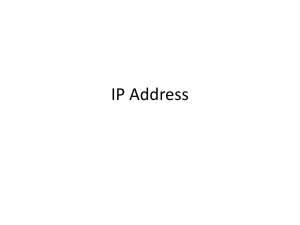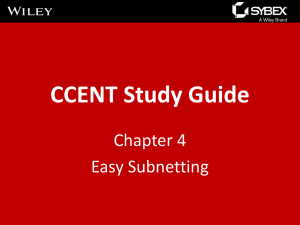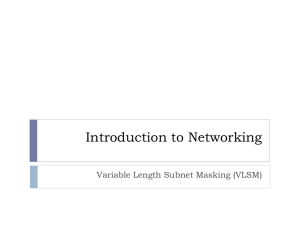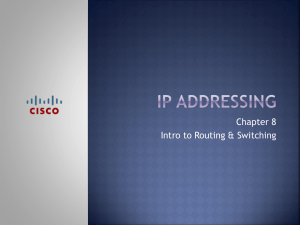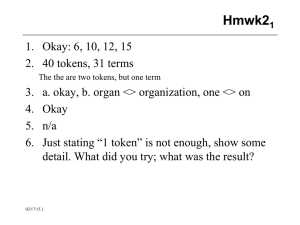vlsm
advertisement
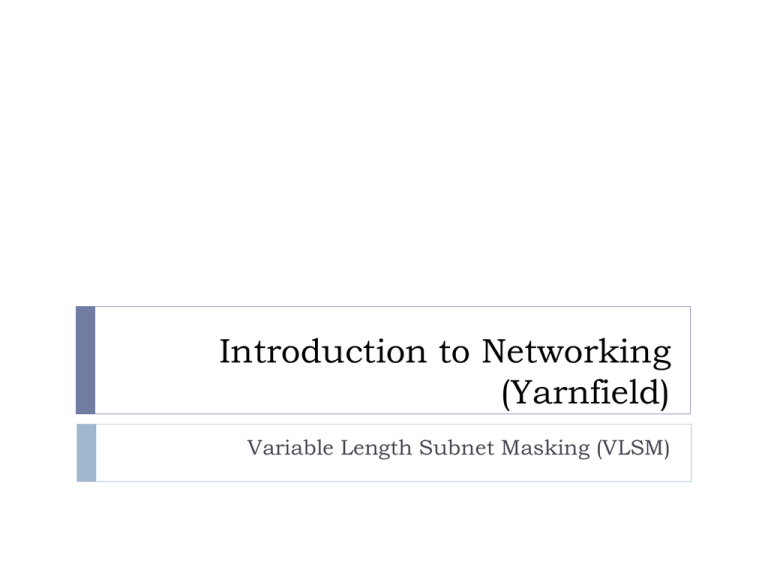
Introduction to Networking (Yarnfield) Variable Length Subnet Masking (VLSM) Objectives Define VLSM Describe the difference between classful subnetting Describe the advantages of VLSM Be able to perform VLSM operations on give IP addresses Classful subnetting exercise 172.80.0.0 255.255.248.0 Find The first five subnet addresses First host, last host and broadcast of each subnet Default gateway How many subnets can be made? How many hosts per subnet? VLSM defined More than one subnet mask Using classful subnetting wastes IP addresses 172.80.40.0 Why? 172.80.40.1 – 47.254 172.80.32.0 172.80.32.1 – 39.254 172.80.16.0 172.80.16.1 – 23.254 172.80.24.0 172.80.24.1 – 31.254 172.80.8.0 172.80.8.1 – 15.254 We need An IP address to perform VLSM on The number of hosts involved in each part of the network We will... Create a number of subnet masks that suit our needs more efficiently than a classful subnetting scheme could Example using a Class C network address 192.168.1.0 60 hosts 120 hosts 30 hosts Process 1. 2. 3. 4. 5. 6. Find the segment with the largest number of hosts connected to it Find an appropriate subnet mask for the largest segment Write down the subnet addresses to fit the subnet mask Take one of the newly created subnet addresses and apply a new subnet mask to it that is more appropriate Write down the subnet addresses to fit the new subnet mask Repeat from step 4 for smaller segments Example continued 1. Find the segment with the largest number of hosts connected to it In the example the largest segment has 120 hosts connected so we must start with this segment To accomodate120 hosts we need to use 7 bits from the host portion of the address (27 - 2 = 126) Example continued 2. Find an appropriate subnet mask for the largest segment If we have borrowed 7 bits for our hosts the subnet mask (in binary) will be 11111111.1111111.1111111.1000000 Convert this to decimal and we get 255.255.255.128 Example continued 3. Write down the subnet addresses to fit the subnet mask Now we need to find the subnet addresses that this subnet mask will create 256 – 128 = 128 Therefore the subnets would be 192.168.1.0 and 192.168.1.128 (remember we can now use subnet zero!) We can now assign 192.168.1.0/25 to accommodate the 120 segment and have 192.168.1.128 to use for the other two segments 60 hosts (62 in total) 120 hosts (126 in total) 192.168.1.0/25 30 hosts (30 in total) Example continued 4. Take one of the newly created subnet addresses and apply a new subnet mask to it that is more appropriate We still have two segments to deal with and we have a new subnet address to work with of 192.168.1.128 We must start with the larger segment, which has 60 hosts To accommodate 60 hosts we need to borrow 6 bits from the host portion of the given IP address 26 – 2 = 62 hosts This will give us a subnet mask of 1111111.1111111.1111111.11000000 which is the same as 255.255.255.192 Example continued 5. Write down the subnet addresses to fit the new subnet mask Now we need to find the subnet addresses that this subnet mask will create 256 – 192 = 64 Therefore the new subnet addresses would be 192.168.1.128 and 192.168.1.192 We can now use 192.168.1.128/26 for the segment with 60 hosts 60 hosts (62 in total) 192.168.1.128/26 120 hosts (126 in total) 192.168.1.0/25 30 hosts (30 in total) Example continued 4. Take one of the newly created subnet addresses and apply a new subnet mask to it that is more appropriate We still have the segment with 30 hosts to deal with We work this out in the same way as before To accommodate 30 hosts we need to borrow 5 bits from the host portion of the IP address 25 – 2 = 30 hosts This will give us a subnet mask of 1111111.1111111.1111111.11100000 which is 255.255.255.224 Example continued 5. Write down the subnet addresses to fit the new subnet mask Now we need to find the subnet addresses that this subnet mask will create 256 – 224 = 32 Therefore the new subnet addresses would be 192.168.1.192 and 192.168.1.224 We can now use 192.168.1.192/27 for the segment with 30 hosts We still have the new 192.168.1.224 subnet which could be used for future growth Result 192.168.1.0 60 hosts (62 in total) 192.168.1.128/26 120 hosts (126 in total) 192.168.1.0/25 30 hosts (30 in total) 192.168.1.192/27 Summary To determine the number of hosts a subnet can support use the formula 2n – 2 Always start the process with the segment with the largest amount of hosts to accommodate Classless subnetting deals with the hosts as opposed to classful subnetting which deals more with subnets Exercise 192.168.2.0/24 7 remote sites, 30 hosts each P to P links between routers Remote A 30 hosts Remote B 30 hosts Remote C 30 hosts Remote D 30 hosts Central Remote E 30 hosts Remote F 30 hosts Remote G 30 hosts Exercise 192.168.3.0 30 hosts 6 hosts Backbone 126 hosts 6 hosts 30 hosts 6 hosts 30 hosts Questions... ...are there any?


